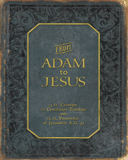Who Were the Magi Who Visited Jesus?
Who were the magi, and should they be part of the Nativity?
January 6 is traditionally celebrated as the day the magi visited Jesus, and it marks the end of the “Twelve Days of Christmas.” These magi, or wise men, saw the rising of a new star in the sky and traveled to Jerusalem to find the newborn king. When they understandably went to the palace to find this king, they set into motion events that would lead to Mary, Joseph, and Jesus fleeing to Egypt and also lead to the death of all boys two years and under in Bethlehem.
“We Three Kings?”
The famous song speaks of “three kings,” but there is nothing in the biblical text to suggest that the magi were kings. The Greek word used to describe them is magos, from which we get the word “magic.” It denotes a person who practiced astrology, dream interpretation, and various types of enchantment. This makes sense, because they made their journey because of a star that rose in the sky. It “was originally applied exclusively to members of a priestly caste of the Medes and Persian who had esoteric skills in interpreting dreams. However, the use of the word broadened to embrace various categories of persons who were marked out by their superior knowledge and ability, including astrologers, soothsayers, and even oriental sages.”1
Matthew’s text says they were “from the east,” which makes it possible they were from Babylon, a popular interpretive option. Because the wise men presented three gifts to Jesus (gold, frankincense, and myrrh), tradition says that there were three wise men. In reality, the Bible doesn’t say how many there were.
How Did the Wise Men Know to Look for the Star?
The Messiah was promised to Israel, and the Jews were expecting him to come around that time. But how did these gentile astrologers know to look for him, and how did they know the vicinity of where to go?
During the Judean exile to Babylon, Daniel rose to prominence among the royal court of wise men when he was able to interpret dreams and make true predictions. While we don’t know the degree to which he converted anyone in the court, some seem to have kept records of his predictions—among which was the coming of the Jewish Messiah (Daniel 7:13–14, 9:24–27).
Were the Wise Men at the Manger?
Nativity sets often include the wise men, leading many to suppose that they were perhaps present at Jesus’ birth alongside the shepherds. However, Nativity sets are in the tradition of religious artwork that exists to teach about biblical narratives, not exactly reproduce a moment in history. Before the average person could read, imagery like the Nativity scene and other religious artwork helped to teach about biblical events. While the magi are included in the infancy narrative of Matthew (hence their inclusion in the Nativity scene), they probably arrived between one and two years after Jesus’ birth.
The Bible gives us several indications that the scene is different than that of the night of Jesus’ birth. Mary and Joseph were situated in a house, while when Jesus was born they were somewhat inconveniently located in some sort of animal housing because there was no room in the upper room.2 Early tradition suggests Jesus was born in a cave (caves were often used to house animals), and the Church of the Nativity is built over a cave site in Bethlehem which tradition states is the place. However, we cannot be certain because the birth accounts do not tell us specifically where Jesus was born. However, by the time the magi came, the family was no longer housed with the animals. Furthermore, Jesus is referred to as a “young child” with the Greek word paidion, not an “infant” with the Greek word brephos, as in Luke 2:12.
Why would it have taken so long for them to get there? Presumably, it took some time for the wise men to gather an envoy and get royal permission for the trip. Camels can travel around 25 miles a day going top speed, meaning the 1700-mile journey from Babylon to Jerusalem would have taken over two months even if the conditions were absolutely ideal.
And after their visit, Herod would not have immediately realized he was fooled and the wise men weren’t coming back. He also may have adjusted the age up to ensure the right boy was killed. Herod was known for being excessively murderous when he believed someone was after his throne. He was not a Jew—he was half-Edomite and half-Arab. He was only king because Rome made him the king. Rumors of a true heir to David would absolutely be enough for him to slaughter some children.
What Was the Star?
There are all sorts of interesting astronomical theories about what the star could have been. However, it likely was not some sort of alignment of stars and planets. First, the star appeared and disappeared, and while the magi could follow it, Herod’s men presumably couldn’t.
Furthermore, the Bible never tells us to search the heavens for astrological signs, so why would God reveal Jesus’ birth via an astrological sign?
Rather, it is likely that the wise men had some records of Daniel’s prophecies, which included the timing of Jesus’ birth (but not the place, which is why they went to Jerusalem, not Bethlehem). They were searching the sky for signs because that’s all they knew to look for.3 God graciously gave them a sign in the sky—not an astrological sign, but the rising of a new star, which was a miraculous occurrence, perhaps even a manifestation of God’s glory. This explains how the star could appear, disappear, appear again, and lead them to a particular house.
Their purpose in coming to see him was to “worship” him. The Greek word proskyneo has various levels of meaning, from showing deference to a person to worshipping God. However, if the magi merely viewed Jesus as human, it would be odd for them to take a long journey to offer costly gifts and worship to a king that had no authority over them. But if they understood him to be God in human flesh, as they might have from Daniel’s prophecies, they might have done exactly that. Matthew often contrasts the faith of gentiles with the faithlessness of Jewish leaders, and the worship of the magi compared with the apathy of the priests who pointed them (and Herod) to Bethlehem is a nice contrast.
Why Gold, Frankincense, and Myrrh?
The gifts of the wise men were imbued with theological significance early in church history. Gold is meant to signify Jesus’ royalty, frankincense his deity, and myrrh his sacrificial death. If the magi meant to prophesy with their gifts, Scripture does not record this detail. Gold, frankincense, and myrrh are all precious and easily portable, so they were suitable to bring on a long journey to honor the newborn king.
Incidentally, the wise men’s gifts may have providentially been given just in time to fund the family’s flight to Egypt. We know from the offering they gave at his dedication that Jesus’ family was poor. Even if Joseph was able to set up shop in Egypt to earn a living, travel would have been expensive.
Jesus, the Savior of the World
While the Old Testament consistently prophesied that the Messiah would bring salvation for Israel, God repeatedly emphasized that the Messiah would not just save Israel, but the whole world
While the Old Testament consistently prophesied that the Messiah would bring salvation for Israel, God repeatedly emphasized that the Messiah would not just save Israel, but the whole world (Isaiah 11:10, 42:1–7, 49:6, 60:1–3). Jesus came to reverse Adam’s curse for all of Adam’s descendants.
The first people recorded as worshipping Jesus were lowly Israelite shepherds and foreign gentiles, while the people who might be expected to know the most about the Messiah’s coming—the Jewish elite with access to the Scriptures that told the exact location of his birth along with its timing—did not worship him but aided Herod in discovering which infants to slaughter.
Footnotes
- John Nolland, The Gospel of Matthew: A Commentary on the Greek Text in New International Greek Testament Commentary, (Grand Rapids, Michigan: W.B. Eerdmans; Bletchley, Milton Keynes, UK: Paternoster Press, 2005), 108.
- The Greek kataluma most likely refers to an upper room in a private house, not an inn. Bethlehem was so small that it likely did not even have a formal inn, and kataluma is also used in Luke 22:11 to refer to the upper room where Jesus and the disciples ate the last supper.
- Perhaps they had also studied other biblical prophecies, like Genesis 49:10 and Numbers 24:17 which mentioned a kingly line and a star rising in Israel.
Recommended Resources

Answers in Genesis is an apologetics ministry, dedicated to helping Christians defend their faith and proclaim the good news of Jesus Christ.
- Customer Service 800.778.3390
- Available Monday–Friday | 9 AM–5 PM ET
- © 2025 Answers in Genesis






